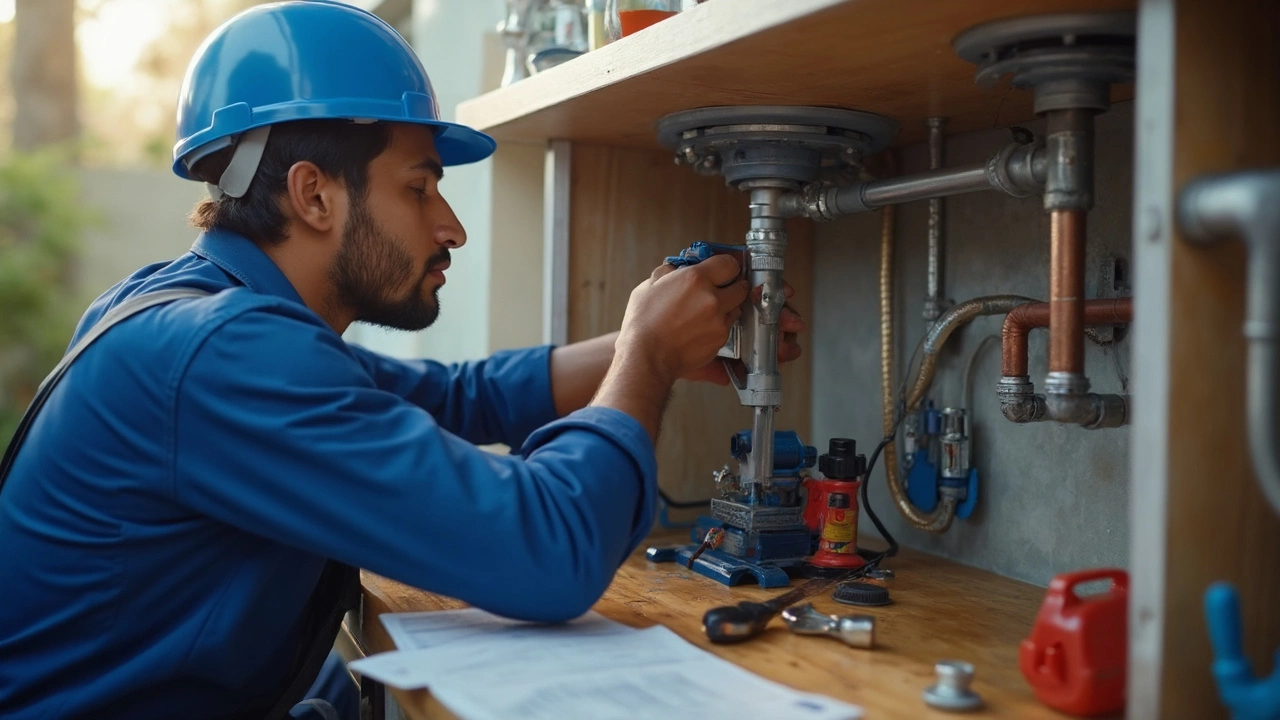Why Are Plumbers So Highly Paid? The Real Reasons Behind Big Paychecks

Most folks are shocked when they hear just how much a plumber can make. But when your bathroom floods at 3 a.m., who else are you calling? Plumbers don’t just unclog toilets—they’re trained to handle everything from busted water heaters to building code headaches that would confuse most people.
It’s not just about physical work, either. Getting certified takes time, grit, and technical know-how. There’s a lot of science packed into those pipes and valves. When you think about it, that job isn’t just messy—it’s a mix of electrical, engineering, and full-on problem-solving. Some states even make plumbers log thousands of hours as an apprentice before they ever call themselves “journeyman.”
One big reason they’re paid so well? Not many people want to do what plumbers do. And when not enough people train for the job, every working plumber is in hot demand. Throw in the fact that you can’t ‘outsource’ a leaking pipe to another country, and you see why salaries keep climbing.
- Why Plumbers Are in Constant Demand
- The Skills and Training Needed
- Risks and Responsibilities on the Job
- How Shortages Drive Up Salaries
- Is Plumbing Worth It? Career Tips
Why Plumbers Are in Constant Demand
If there’s one job that never seems to slow down, it’s plumbing. No matter the season or the economy, people always need running water, working toilets, and hot showers. When any of that fails, you need a fix right now—not next week. This is one of the main reasons plumber salary stays higher than most hands-on jobs.
Here’s a simple truth: Modern life depends on plumbing. Residential and commercial properties all run on complicated networks of pipes. Even minor leaks cause major headaches, damage, and expense if ignored. Plumbers fix these issues fast, saving homes and businesses from bigger disasters.
Now, look at some facts:
| Fact | Details |
|---|---|
| Number of U.S. plumbers (2024) | Over 500,000 |
| Expected job growth (2024-2034) | 2% per year |
| Average emergency call hourly rate | $150 - $300 |
| Estimated annual water leaks nationwide | 1 trillion+ gallons lost in homes |
Demand gets another boost from aging buildings. A lot of homes and offices were built decades ago, and that old plumbing isn’t built to last forever. When pipes corrode, or drains block up, you need a pro.
Plus, new construction projects never stop. Every new house or shop means pipes and fixtures go in—someone has to install them right, or it’s trouble down the road. And with more folks moving to cities and suburbs, the workload only gets bigger.
Long story short: Plumbing isn’t going away. Floods, leaks, and breakdowns are part of life, and only skilled plumbers keep things flowing. That’s why their phones always ring—and why their paychecks stay solid, even when other industries slow down.
The Skills and Training Needed
If you think plumbing is something you can just 'pick up' one weekend, think again. Plumbers have to know a lot, and the path to becoming one isn’t exactly a walk in the park. First off, you need to finish high school or get a GED. Then, most folks jump into an apprenticeship, which mixes classroom lessons with real-world work. Apprenticeships typically last 4 to 5 years, and during that time, you’re working side-by-side with pros, learning everything from local plumbing codes to hands-on pipe repair.
The classroom side often covers topics like:
- Pipe installation and repair techniques
- Water heating systems
- Blueprint reading and drafting
- Building codes and regulations
- Math for measuring and estimating
- Workplace safety and first aid
After an apprenticeship, there's usually a licensing exam. No shortcuts here—you’ll get tested on all that technical knowledge and safety rules. In the U.S., every state sets its own rules, and some even require extra specialty licenses for things like gas piping. Want proof? Here’s a quick look at how much training is required in a few states:
| State | Apprenticeship Length (Years) | Required Classroom Hours |
|---|---|---|
| California | 4 | 576 |
| Texas | 4 | 288 |
| New York | 5 | 744 |
But let’s not forget soft skills. Communication matters too. Plumbers have to talk to frustrated homeowners and coordinate with builders and inspectors. Problem-solving is huge in this field—pipes don’t always do what textbooks say. And with all the tech that’s creeping into homes, knowing a little about smart devices and new materials pays off big time.
If you’re considering plumber salary as your north star, don’t skip training. That knowledge is what keeps jobs safe, legal, and high-paying.

Risks and Responsibilities on the Job
Being a plumber isn’t just about turning a wrench. There are real risks that most folks don’t think about until they’re face-to-face with a busted pipe. For starters, plumbers deal with water, gas, and sometimes even sewage every day. This mix can turn dangerous fast. Gas leaks aren’t just a hassle—they’re a literal explosion risk. Messing up connections can cause floods, property damage, or hazardous mold down the road.
On top of that, plumbers are always moving, lifting, kneeling, or squeezing into tight spots. This takes a toll on the body. The U.S. Bureau of Labor Statistics reports that plumbers have one of the highest rates of injuries among all construction jobs. We’re talking back strains, cuts, burns, eye injuries, and sometimes worse.
Here’s a quick look at the kinds of accidents and hazards plumbers face on the job:
- Exposure to sewage and biohazards, which can spread diseases like hepatitis and E. coli
- Falls from ladders or slippery surfaces
- Risks related to electrical wiring when working near water heaters or pumps
- Confined spaces with poor ventilation, leading to possible fume inhalation
- Heavy lifting and repetitive strain injuries
But it’s not all about the dangers. Plumbers have a lot of responsibility. If a job is done wrong, it’s not just a headache. Water damage can cost homeowners thousands, and faulty gas lines can be flat-out deadly. That’s why states require extensive training and strict licensing. Mistakes on pipework, backflow prevention, or main water supply installation can leave a home or business at serious risk.
This table shows just how often and what types of injuries plumbers tend to face:
| Type of Injury | Percent of Plumbing Injuries (US, 2023) |
|---|---|
| Muscle Strains/Sprains | 35% |
| Cuts/Lacerations | 22% |
| Falls | 18% |
| Burns | 10% |
| Exposure to Biohazards | 8% |
| Other | 7% |
All these risks and responsibilities add up—that’s one big reason plumber salary keeps climbing. People pay not only for the physical work, but for the skill and guts it takes to do the job safely and right, every single time.
How Shortages Drive Up Salaries
Ever notice how hard it is to get a plumber out on short notice? That's not a fluke—there just aren’t enough trained plumbers to go around. According to the U.S. Bureau of Labor Statistics, there were more than 600,000 job openings for skilled trades like plumbing in 2024, but only about 400,000 trained workers to fill them. That’s a big gap in the workforce.
This shortage is pushing up wages. When every repair company is competing for the same small pool of qualified workers, plumbers can command higher pay. Employers are even offering sign-on bonuses, extra perks, and flexible schedules just to recruit new talent.
Several things are causing this shortage:
- The average plumber in the U.S. is over 42 years old, and lots are retiring soon.
- Fewer young people are training for hands-on jobs, choosing college instead.
- Demand for plumbing is growing—new houses, old pipes, and more complicated systems mean more work than ever.
All of this means the plumber salary has shot up over the past decade. Check out the average national salaries below:
| Year | Average Plumber Salary (USD) |
|---|---|
| 2015 | $51,000 |
| 2020 | $57,000 |
| 2024 | $61,800 |
And those are just averages. In cities facing severe labor shortages like San Francisco or New York, it isn’t rare for an experienced plumber to make $100,000 or more, especially with overtime or on-call work. So next time it seems expensive to fix a leaky faucet, remember, you’re paying for skill that’s in short supply—and high demand.

Is Plumbing Worth It? Career Tips
If you’re weighing up whether plumbing is a smart career move, you’re not alone. More people are starting to look past the old stereotypes and realizing this trade can be a total game-changer. Forget about being stuck at a desk—plumbers enjoy variety, a sense of pride fixing real problems, and, let’s be honest, solid paychecks.
Here’s the reality: Most plumbers in the U.S. earn between $50,000 and $80,000 a year, and some make six figures running their own businesses. The Bureau of Labor Statistics says the demand for plumbers will keep growing—about 4% more jobs every year through 2032. Plumbing isn’t recession-proof, but even during economic slumps, people still need hot showers and working toilets.
So, what does it really take to get there? It’s not just turning wrenches and dealing with leaks. Training matters. Here’s what most new plumbers go through:
- Find a good training program—usually takes about 4-5 years to finish an apprenticeship.
- Log about 2,000 hours a year on the job, learning everything from basic repairs to advanced system installs.
- Pass state exams to become licensed (the big step—no license, no work).
- Stay up to date with code changes and safety rules, thanks to ongoing courses.
If you’re good with your hands, don’t mind a little hard work, and like solving problems that actually matter, plumbing might be the perfect fit. Want flexibility? Plenty of plumbers work for themselves, set their own rates, and have real freedom. Some even specialize in green tech or industrial setups and earn more.
Check out these numbers to see where plumbers stand in the skilled trades:
| Trade | Median Pay (2024) | Projected Growth (2022-2032) |
|---|---|---|
| Plumber | $61,610 | +4% |
| Electrician | $60,240 | +6% |
| HVAC Technician | $51,390 | +5% |
| Carpenter | $50,120 | +2% |
Last tip: Don’t skip soft skills. Being friendly and honest with customers is how plumbers build a great reputation. That’s how you land repeat clients and referrals, which can be worth a lot more than a single big job. If you’re serious about a stable career with rising pay, check out a plumber salary in your area and see what you could be making in just a few years. Real skills, real income, no college debt—that’s a win.

Post-Comment